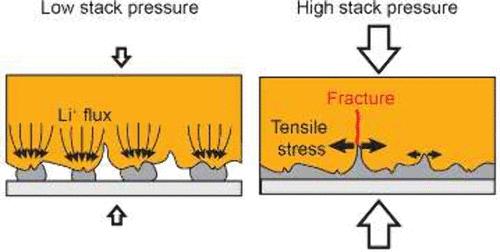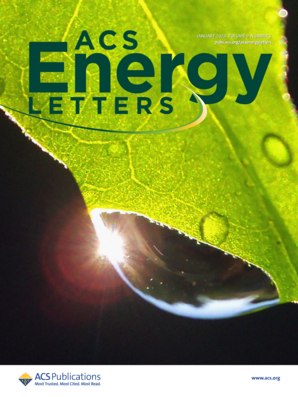Filament-Induced Failure in Lithium-Reservoir-Free Solid-State Batteries
IF 19.3
1区 材料科学
Q1 CHEMISTRY, PHYSICAL
引用次数: 0
Abstract
Lithium-reservoir-free solid-state batteries can fail due to electrical shorting as a result of fracture and lithium metal filament formation. Mechanical stress at the solid electrolyte surface can induce fractures, which promote lithium filament growth. This stress arises from both electrochemical sources, due to lithium electrodeposition, and mechanical sources, such as external stack pressure. Solid electrolyte surface roughness and the applied stack pressure together affect stress development. This study combines electrochemical experiments, 3D synchrotron imaging, and mesoscale modeling to explore how stack pressure influences failure mechanisms in lithium free solid-state batteries. At low stack pressure, irregular lithium plating and the resulting high local current density drive failure. At higher stack pressure, uniform lithium plating is favored; however, notch-like features in the surface of the solid electrolyte experience high tensile stress, leading to fractures that cause premature short-circuiting.

求助全文
约1分钟内获得全文
求助全文
来源期刊

ACS Energy Letters
Energy-Renewable Energy, Sustainability and the Environment
CiteScore
31.20
自引率
5.00%
发文量
469
审稿时长
1 months
期刊介绍:
ACS Energy Letters is a monthly journal that publishes papers reporting new scientific advances in energy research. The journal focuses on topics that are of interest to scientists working in the fundamental and applied sciences. Rapid publication is a central criterion for acceptance, and the journal is known for its quick publication times, with an average of 4-6 weeks from submission to web publication in As Soon As Publishable format.
ACS Energy Letters is ranked as the number one journal in the Web of Science Electrochemistry category. It also ranks within the top 10 journals for Physical Chemistry, Energy & Fuels, and Nanoscience & Nanotechnology.
The journal offers several types of articles, including Letters, Energy Express, Perspectives, Reviews, Editorials, Viewpoints and Energy Focus. Additionally, authors have the option to submit videos that summarize or support the information presented in a Perspective or Review article, which can be highlighted on the journal's website. ACS Energy Letters is abstracted and indexed in Chemical Abstracts Service/SciFinder, EBSCO-summon, PubMed, Web of Science, Scopus and Portico.
 求助内容:
求助内容: 应助结果提醒方式:
应助结果提醒方式:


